Senua’s Saga: Hellblade II: The Kotaku Review
- Oops!Something went wrong.Please try again later.
I’m on a path to find reprieve from the suffering around me. But as I turn the next corner of clouding darkness, a bright red light paralyzes me as the forceful and commanding voice of my father tells me that not only am I doomed to fail in my struggles, but that I am actively causing the very harm I am seeking to alleviate. Be it through failure or a curse that he expects me to believe I carry with me that will spread to others, he calls me his daughter with a possessiveness that rattles me. It inspires fear and rage. Yet I continue to move forward, to find a way through, to find spaces where his corruption hasn’t spread. And I do this not only for myself, but for others to whom I have promised aid. But in my quest to kill godlike forces that are causing misery, I am ever aware of a creeping darkness that threatens to consume me and others. What must I do to heal this world? Is that what I’m here to do? Can I do this? As I hear my father’s voice again, reminding me of his abuse, I realize I have no choice. I must survive and bring an end to the suffering of all those I encounter.
Arriving on May 21, 2024 for Xbox Series X/S and PC, Senua’s Saga: Hellblade II picks up shortly after the events of 2017’s Hellblade: Senua’s Sacrifice. Continuing the story of Senua, a Pictish warrior who experiences psychosis and has lived through intense and tragic trauma, Saga delivers an experience that will be familiar to those who played Sacrifice. Saga is a tightly focused narrative of magical realism, though those magical elements may largely be part of how Senua perceives the world, rather than how it actually is. (And really, how much can any of us can attest to how reality “actually” is?) Senua’s altered perceptions of reality enable her to contend with seemingly supernatural forces inspired by Norse mythology. But she also, and perhaps most importantly, is in a battle with her own trauma in a way that allows her to see into the internal struggles of others.
Buy Senua’s Saga: Hellblade II: Amazon | Best Buy | GameStop
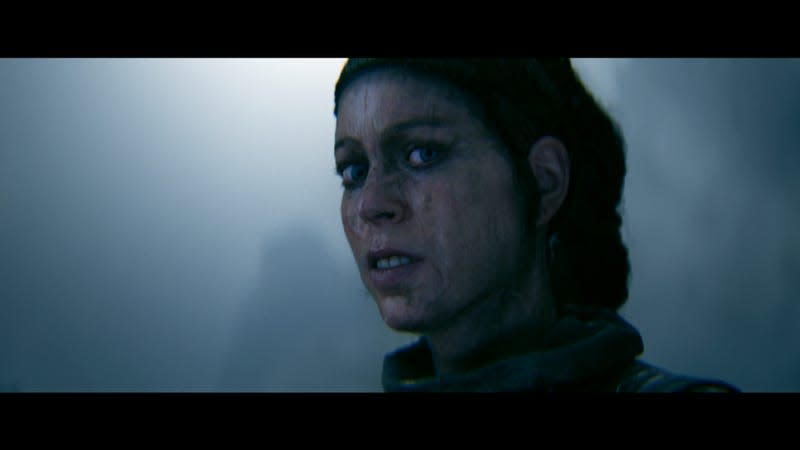
A third-person action-adventure game, Saga features cryptic mazes and puzzles typically solved by observing matching runic symbols and other methods of altering the world around Senua to traverse the environment. Long sequences of maze-drifting give way to moments that prioritize the game’s combat. Battles consist of one-on-one showdowns in which Senua must use her skills with a blade and her mirror, which grants her a limited bullet-time (or perhaps sword-time?) ability to deal rapid slashes against her opponent.
There are also plenty of lengthy cutscenes and “walk-and-talk” moments of exposition and dialogue, both from the three NPCs who accompany Senua on her journey and from the voices that speak to her in her mind, which are inspired by contemporary understandings of psychosis in the 21st century and produced in collaboration between developer Ninja Theory and experts in the field of psychosis and mental health. That experience is brought to life through a binaural audio design that necessitates playing this game with headphones. With headphones, the audio takes on outward and inward spatial roles: The world outside Senua sounds vividly real, and the internal sound of the voices she hears create distorted, gripping emotional contours over the narrative and virtually all other elements of the game.
In all of its elements, Hellblade II delivers numerous highs, and what many will find as some lows. Like the first Hellblade, the sequel has a run-time of about eight to nine hours. Though there is very little room for exploration outside of Saga’s main story, the game does reward another playthrough or two upon completion; you may replay the game with different characters narrating portions of the game’s story. It’s a neat and rewarding way to re-experience the game immediately after–and it does really help you connect many dots you might’ve missed on your first time through.
There’s also an additional unlockable feature rewarded for discovering all of the game’s hidden mythological lore lessons. Sadly, I cannot speak to this last element as, despite finishing the story in just under nine hours, I was unable to discover all of these hidden “collectibles.”
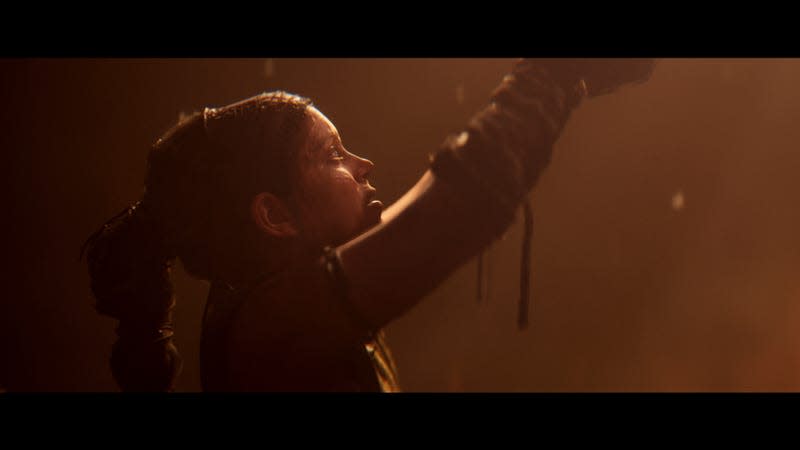
Hellblade II rarely failed to provide me with an emotionally stirring experience that ensnared my full attention and refused to let it go. And I didn’t want it to. I found it to be a riveting journey of lush, beautiful darkness and torment with a beating heart of hope and perseverance. It left a dramatic, if not haunting, impression on me, one that’s still capable of bringing me to tears as I make my way through it again with the alternate narration.
Senua’s story continues
Senua’s Saga follows the warrior as she allows herself to be captured by Vikings who are rounding up Picts to be transported to Iceland as slaves. These captors are of the same militant force that slaughtered her village and her beloved, and her motivations are both a kind of revenge as well as a desire to prevent the continued suffering of her people.
Following her violent arrival in the north, Senua is introduced to additional characters and the central driving focus of the narrative: The people in Iceland live under the threat of unstoppable, menacing giants.
Over the course of six chapters, Senua must persist through difficult trials that bend reality for her, and by extension, for you. Challenging you with solving cryptic puzzles strewn about its mazes, fighting a variety of tough foes in blade-to-blade combat, and dealing with its protagonist’s own inner turmoil, Saga’s premises are simple, but Senua herself is not. She experiences a persistent chatter from the “Furies,” voices she hears in her mind that narrate her decisions, question them, encourage her, doubt her, and offer up unpredictable lines of dialogue that take on different tones throughout the course of the game.
It can be a lot to sit with, and as you face vicious depictions of violence and human subjugation, the voices frequently turn to hold Senua accountable for everything around her. As a result, she experiences swallowing thought spirals of self doubt and failure which stem…yup, from her father.
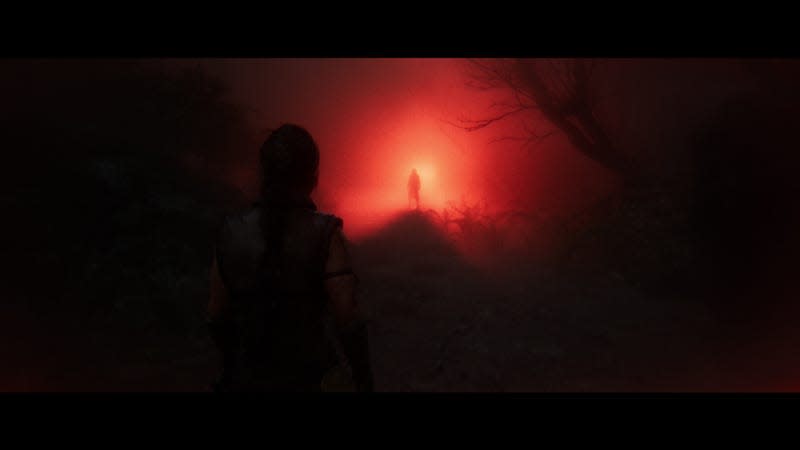
Her father is an abusive figure in her life. He persists in her mind and attempts to cast her as being responsible for the suffering she has endured, as well as that which she witnesses around her.
The end result is a dark and multidimensional narrative that shifts and shapes itself through mythology and metaphor. It’s a gripping, painful experience through arduous mental anguish and trauma. It outpaces its existence as a fantasy game and becomes relatable to real life real fast. And you should be prepared for that going into it.
At least the girl has some friends. As the story progresses, Hellblade II introduces three other characters who’ll accompany Senua. They won’t fight alongside you, and are often absent during the majority of Senua’s trips through altered states of reality, but they have a direct and vested interest in the struggles of those living in fear of the giants.
These NPCs offer a dynamic arguably absent from Saga’s predecessor. Here, Senua must contend not only with the struggles of her mind and the supernatural forces surrounding her, but also with the bonds she must forge with these characters, some of which start off rougher and more complicated than others.
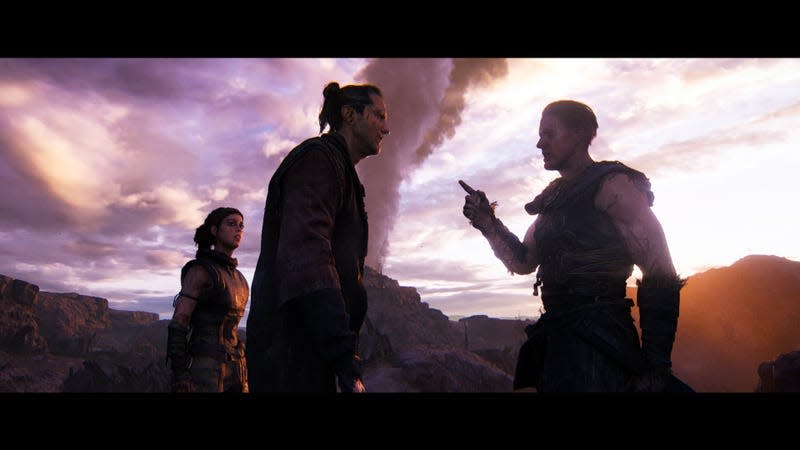
It’s an interesting change from the first game, one that gives this game a richer and more varied range of characters to center while also making the world feel larger.
Unlike Sacrifice, this isn’t just a story of Senua’s own trauma and inner turmoil; it’s also about those who have lost safety and security as a result of the giants. That said, Saga is clearly dealing with themes of human violence that aren’t just about menacing monsters that go bump in the night. Whether or not the supernatural elements of the game are merely powerful metaphors for human violence and trauma or not, Senua persists through the same reality as everyone around her. She just sees it differently. And with that, she brings hope to the world.
The presence of additional flesh-and-blood characters positions Senua as a different kind of protagonist than she was in the first game. She’s now a savior for the people she encounters. And her unique perspective on reality, something seen as a gift by others, is valued for what she can do and learn. We get to see who she is in relation to others, and how her experience of reality positions her in this culture. It’s a smart decision for the sequel to make.
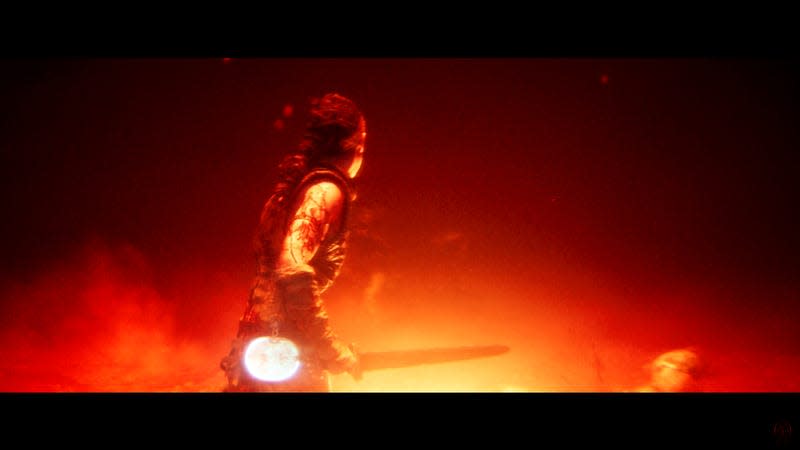
Wear headphones, kill the lights, turn off your phone, and focus
When you start up Hellblade II, you will be told the game is best experienced with headphones. And while I imagine that a well-designed, likely expensive, home theater setup could deliver a compelling experience, headphones will better create the sense that the game lives in your head in a powerful way.
The only way to experience Hellblade II, in my estimation, is to devote as much of your attention and sensory abilities to it as possible. Saga is a game that lives to exist on a large screen in a dark room, and you should remove all possible distractions.
Saga presents a direct and focused path that Senua and her inner demons traverse as she searches for solutions for the people of Iceland. There are no menu systems to dive through and virtually no HUD elements to distract you. This game wants its world to swallow you up.
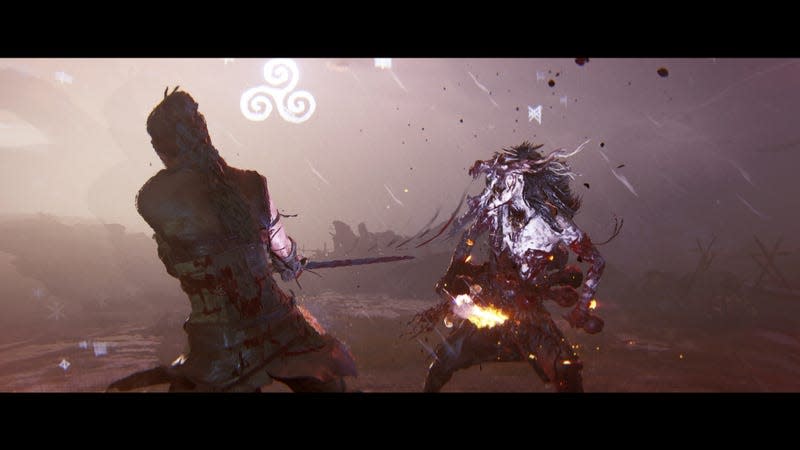
Hellblade II rapidly dissolves the barriers between cutscenes and interactive gameplay. Sometimes this does make it hard to tell exactly when you’re in control of the game, which can be disorienting. And in fact, I think the way Saga moves seamlessly from moments of interaction to moments of observation contributes to a bit of narrative exhaustion; your actions in the game are almost always focused on the next story beat with little time to stop for air. And no one’s here to ask you if you want to try your hand at some fishing, or gather 30 units of sheeps’ wool to make a new garment for Senua.
The end result is a seamless, distraction-free narrative journey that pulls you in and wows your senses with its audio and visual flair. And while there are definitely impressive technological feats on display here, they all serve to create an experience that bucks so many current trends that often define what we think makes a game “game-like.” And I mean that in a good way.
A breath of focused fresh air amongst modern games
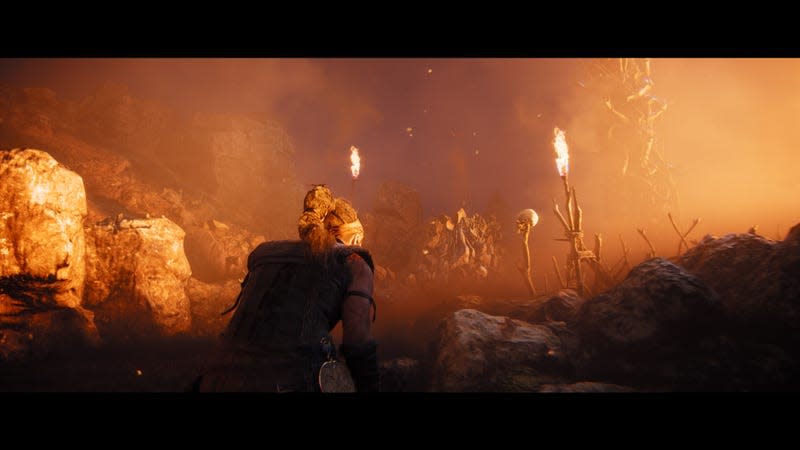
As I’ve said, Saga has virtually no HUD. It has no fetch quests, no crafting systems that force you to punch trees for hours, no lengthy list of hit-or-miss side activities, no mini-games. It has no RPG stats to spec out and min/max. There are no builds to perfect, no unique weapons to find, no skill trees to traverse. And there’s no ever-present NPC or nagging menu system that begs you to take your attention away from the immediacy of pain and suffering of the narrative.
The combat is certainly not as adorned as that in many other action games. You won’t be memorizing long lists of combos. And enemy movements can be hard to read in the heat of battle. But these sequences are delivered with such a visceral corporeality through their stellar animation work, anguished voice performances, and pounding, hypnotic music co-created by mystical folk band Heilung that it doesn’t matter.
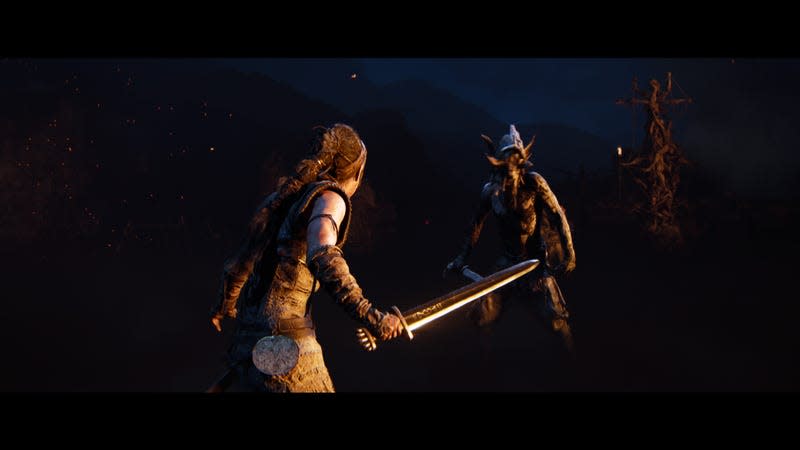
The direct and simple nature of the controls allows you to narratively immerse yourself in Senua’s struggle. Succeeding in combat grants the feeling of growing with Senua as a warrior, while suffering from poorly timed attacks sees her battered about in a way that feels thematically congruent with the game’s themes of struggle and strife. Every attack you land as Senua, or suffer from an enemy who got the better of you, seamlessly feels like part of the narrative experience.
Hellblade II is also very short, and I do wonder if it could’ve spent its time a little better. Fight sequences get a little repetitive with constant, rotating one-on-one showdowns. And some of the puzzles, particularly an early one after Senua learns a bit more about the plight of Iceland, overstay their welcome. It’s very easy to get lost. But just when I began to feel a little tired of skulking around in the darkness, the game would take a narrative turn that hit me square in the heart, thanks in no small part to actor Melina Juergens’ emotionally powerful performance as Senua.
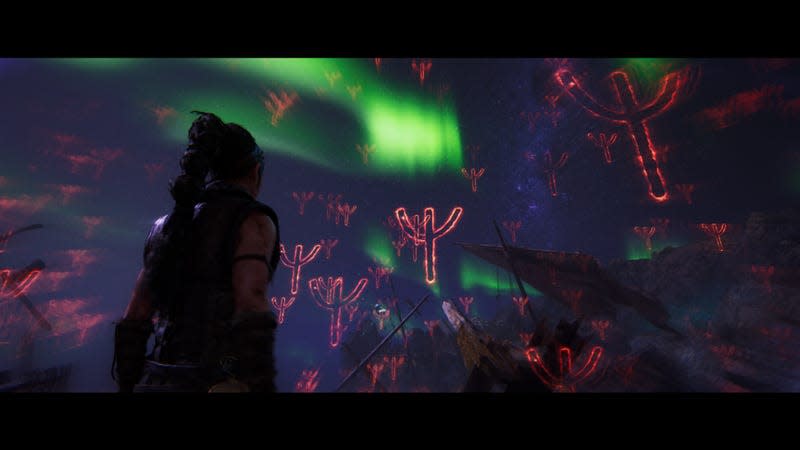
Lasting just eight or nine hours, you can maybe work your way through the game in a weekend. In a world of games that want to have your attention forever, that is one of the great gifts of Saga. There’s an almost counter-cultural vibe going on with this game, one where you think less of how to “game” it, and instead are simply focused on the gripping narrative, which itself is aiming to subvert a few expectations of what a warrior is and what they should do to earn such a title. The game sustains that up until its conclusion, which I’m still thinking about as I come to understand what this journey has been for Senua…and perhaps for myself.
Hellblade II is a special game of complicated emotions. In fact, on one occasion when I attempted to play it on Steam Deck (where the experience was less than ideal but but certainly playable), I had to stop as I was in public and began to get overly emotional during a specific part that meditates heavily on identity and suffering.

Saga is focused on unearthing the nature of monsterhood in a way that you might not be prepared for, especially if you’ve had struggles with mental health or have deep personal traumas of your own. And, I might add, this is especially the case if you identify as a woman. You should, and perhaps must, take the time to care for your own emotions during Saga’s eight-hour duration, one which I think ultimately will lead you to perhaps consider ways in which both individuals and humanity might escape from perpetual, spiraling patterns of destruction.
Senua’s enduring compassion and dedication through a rage-inducing journey of pain left a significant impression on me. Despite dealing with a fantastical world, Hellblade II is often, hauntingly, all too real.
Buy Senua’s Saga: Hellblade II:Amazon | Best Buy | GameStop
.

